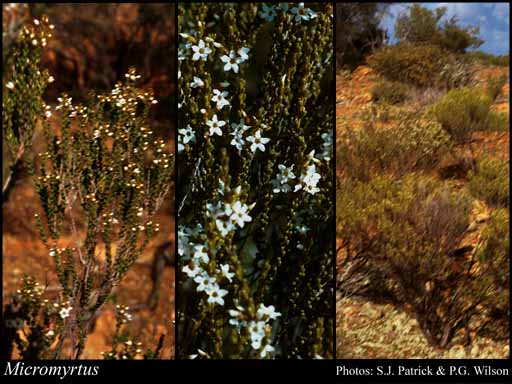- Reference
- Gen.Pl. [Bentham & Hooker f.] 1(2):700 (1865)
- Name Status
- Current

Scientific Description
Common name. Heath-myrtles. Family Myrtaceae.
Habit and leaf form. Shrubs; evergreen; bearing essential oils. Plants with neither basal nor terminal concentrations of leaves; to 0.3–2 m high. Leptocaul. Mesophytic, or xerophytic. Leaves minute to small; opposite; decussate; ‘herbaceous’, or leathery; petiolate to sessile; gland-dotted; aromatic; edgewise to the stem, or with ‘normal’ orientation; simple; epulvinate. Leaf blades dorsiventral, or isobilateral, or centric; entire; flat; linear, or lanceolate, or oblong, or ovate; linear, or obovate, or oblong, or elliptic, or orbicular; pinnately veined, or parallel-veined, or one-veined; cross-venulate, or without cross-venules. Mature leaf blades adaxially glabrous, or pubescent (when margins ciliate); abaxially glabrous, or pubescent (when margins ciliate). Leaves without stipules; without a persistent basal meristem. Leaf anatomy. Hairs present, or absent. Stem anatomy. Secondary thickening developing from a conventional cambial ring.
Reproductive type, pollination. Fertile flowers hermaphrodite. Unisexual flowers absent. Plants hermaphrodite. Entomophilous, or ornithophilous. Pollination mechanism conspicuously specialized, or unspecialized.
Inflorescence and flower features. Flowers solitary; axillary (forming terminal ‘heads’ or clusters); subsessile to sessile; (bi) bracteolate. Bracteoles persistent, or deciduous. Flowers minute to small; regular, or somewhat irregular; zygomorphic. The floral asymmetry (when noticeable) involving the perianth. Flowers 5(–6) merous; cyclic. Free hypanthium present (petals ‘inserted on the calyx’); campanulate, or obconic, or turbinate, or tubular; not extending beyond ovary, or extending beyond ovary; adnate to ovary, ribbed or granular, may be dorsiventrally compressed. Perianth with distinct calyx and corolla; 10, or 12; 2 -whorled; isomerous. Calyx present; 5(–6); 1 -whorled; polysepalous; imbricate, or valvate; exceeded by the corolla, or more or less equalling the corolla; persistent, or not persistent. Sepals oblong, or ovate, or orbicular. Corolla present; 5(–6); 1 -whorled; polypetalous; imbricate; regular; white, or cream, or yellow, or pink to purple; persistent, or deciduous. Petals elliptic, or ovate, or orbicular; clawed, or sessile. Androecial members definite in number. Androecium 5, or 10, or 12. Androecial members unbranched. Androecial sequence determinable, or not determinable. Androecial members free of the perianth; all equal, or markedly unequal; free of one another; 1 -whorled (apparently), or 2 -whorled. Stamens 5, or 10, or 12; attached on the rim of the hypanthium; remaining included (shorter than the petals); all more or less similar in shape; isomerous with the perianth, or diplostemonous; alternisepalous; all opposite the corolla members, or both opposite and alternating with the corolla members; erect in bud, or inflexed in bud. Filaments not geniculate; filiform, or strap-shaped. Anthers all alike; dorsifixed; versatile; dehiscing via longitudinal slits; introrse; bilocular; bisporangiate, or tetrasporangiate; appendaged (the subglobular gland on the connective less than half as large as the anther), or unappendaged (when the gland inconspicuous). Gynoecium 2 carpelled. The pistil 1 celled. Gynoecium syncarpous; eu-syncarpous; inferior. Ovary unilocular; 1 locular. Epigynous disk present. Gynoecium stylate. Styles 1; simple; apical; not becoming exserted; hairless. Stigmas 1. Placentation apical (to lateral). Ovules in the single cavity 2–10; pendulous; collateral (or radially arranged); non-arillate; anatropous.
Fruit and seed features. Fruit non-fleshy; indehiscent; a nut; 1 celled; 1(–3) seeded. Seeds non-endospermic; ellipsoidal to reniform; wingless. Cotyledons 2. Embryo curved.
Geography, cytology, number of species. Native of Australia. Endemic to Australia. Australian states and territories: Western Australia, South Australia, Northern Territory, Queensland, New South Wales, Victoria, and Australian Capital Territory. Eremaean Botanical Province.
Etymology. From the Greek for "small" and "myrtle"; the genus is in the myrtle family Myrtaceae.
Keys
A Key to Western Australian Species in the Chamelaucieae Tribe of Myrtaceae
B.L. Rye, M.D. Barrett, T.D. Macfarlane, N.S. Lander, M.E. Trudgen, N.G. Marchant, K.R. Thiele